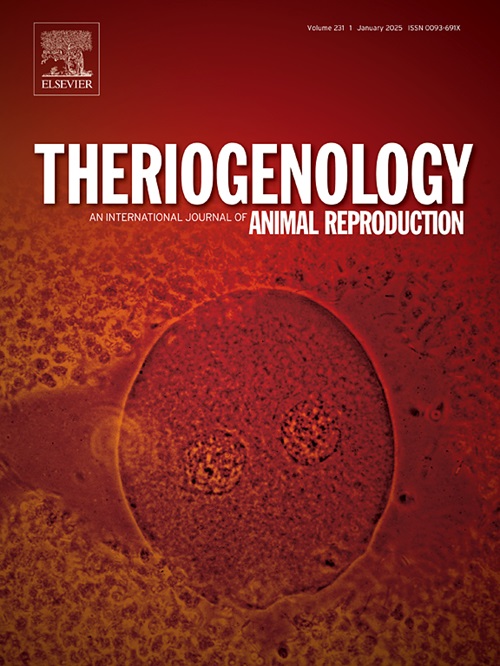Results of the “test-freeze” approach in a commercial program of stallion sperm cryopreservation and the relationship between pre-freeze sperm quality and “freezability.”
IF 2.4
2区 农林科学
Q3 REPRODUCTIVE BIOLOGY
引用次数: 0
Abstract
In the current study, we report the effect of different commercially available semen freezing extenders utilized for the “test-freeze” procedure for 13 years (2010–2023) as part of a commercial program of stallion sperm cryopreservation. Ejaculates obtained from sexually active and healthy stallions (n = 124) were cryopreserved using up to five commercially available semen freezing extenders (Lactose-EDTA [LE], MFR5, CryoMax LE [CMLE], CryoMax MFR5 [CMMFR5] or BotuCrio [BC]). Post-thaw sperm motility (total motility – TM [%]; progressive motility – PM [%]; and curvilinear velocity – VCL [μm/s]), sperm viability (VIAB [%]), and sperm DNA damage (COMPɑt [%]) were compared among semen freezing extenders. Overall, TM, PM, and VIAB were similar for extenders LE, CMLE, and BC (P > 0.05) while higher than for extenders MFR5 or CMMFR5 (P < 0.05). Mean VCL was lower for extender LE than for extender BC (P < 0.05). An effect of semen extenders on mean COMPαt was not observed (P > 0.05). The proportion of ejaculates that yielded four different post-thaw sperm “freezability” indices, based on the average value between post-thaw TM and VIAB (MV; MV ≤ 41 % [LOW]; MV 42–54 % [AVERAGE]; or MV ≥ 55 % [HIGH]), or post-thaw PM: ≥30 %, was calculated. Extenders MFR5 and CMMFR5 yielded a higher proportion of stallions in the LOW category (36 and 37 %, respectively) compared to extenders LE (22 %), CMLE (20 %), or BC (21 %; P < 0.05). For the HIGH and PM ≥ 30 % categories, extenders LE (16 and 65 %), CMLE (15 and 66 %), and BC (15 and 61 %) yielded a higher proportion of stallions than extenders MFR5 (4 and 40 %) or CMMFR5 (2 and 45 %), respectively (P < 0.05). For the AVERAGE category, an effect of semen extenders was not observed (60–63 %; P > 0.05). The relationship between pre-freeze sperm quality parameters (i.e., sperm motility, morphology [Normal], viability, and COMPɑt) and the indices of post-thaw “freezability” (LOW, AVERAGE, HIGH, PM ≥ 30 %) was also determined. The percentages of TMOT and Normal in fresh semen yielded the highest ROC values related to “freezability,” irrespective of the index used: 1) LOW = % Normal – AUC 0.8328 (P < 0.0001); 2) AVERAGE = TMOT – AUC 0.5875 (P = 0.055); 3) HIGH = % TMOT – AUC: 0.8015 (P < 0.0001); 4) PM ≥ 30 % = % Normal – AUC 0.8392 (P < 0.0001). This study provides clinically relevant data regarding the effect of different semen freezing extenders on post-thaw stallion sperm quality and the potential relationship between some sperm quality parameters commonly assessed in practice and post-thaw sperm “freezability” in stallions.
求助全文
约1分钟内获得全文
求助全文
来源期刊

Theriogenology
农林科学-生殖生物学
CiteScore
5.50
自引率
14.30%
发文量
387
审稿时长
72 days
期刊介绍:
Theriogenology provides an international forum for researchers, clinicians, and industry professionals in animal reproductive biology. This acclaimed journal publishes articles on a wide range of topics in reproductive and developmental biology, of domestic mammal, avian, and aquatic species as well as wild species which are the object of veterinary care in research or conservation programs.
 求助内容:
求助内容: 应助结果提醒方式:
应助结果提醒方式:


